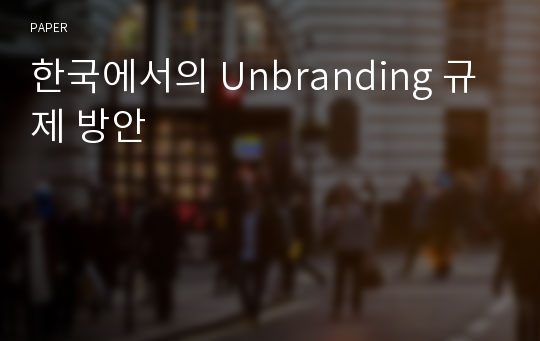* 본 문서는 배포용으로 복사 및 편집이 불가합니다.
서지정보
ㆍ발행기관 : 서울대학교 기술과법센터
ㆍ수록지정보 : LAW & TECHNOLOGY / 10권 / 1호
ㆍ저자명 : 이상희
ㆍ저자명 : 이상희
목차
요약문I. 서론
II. 언브랜딩의 정의 및 규제의 필요성
1. 언브랜딩의 정의
2. 언브랜딩의 예
3. 언브랜딩 규제의 필요성
III. 현행법상 언브랜딩에 대한 규제
1. 상표법에 의한 규제
2. 부정경쟁방지 및 영업비밀보호에 관한 법률에의한 규제
3. 표시·광고의 공정화에 관한 법률에 의한규제
4. 소비자기본법 적용 여부
IV. 결론
<ABSTRACT>
한국어 초록
언브랜딩이라 함은 브랜드를 없애거나 그 사용 을 선택적으로 줄이고 이전의 상표를 연상하기 힘 든 새로운 상표를 만들어 사용하는 것을 말한다. 대 체로 언브랜딩은 구브랜드 자체의 부정적인 연관 성이 긍정적인 연관성을 넘어서는 경우 또는 순수 하게 부정적인 의미만 가지고 있어 자산이 아닌 부 담으로 작용하는 경우에 일어난다.언브랜딩을 하는 것은 기업의 경영상 전략으로 상표권자의 자유이다. 하지만, 언브랜딩은 때때로 크게 2가지의 소비자 혼동을 야기한다. interbrand 혼동과 intra-brand 혼동이 그것이다. interbrand 혼동이라 함은 언브랜딩 기업의 신브랜드가 타 기업의 브랜드와 비슷하여 소비자의 혼동을 일 으키는 경우를 말하고, intra-brand 혼동이란 신브 랜드가 타 기업의 브랜드와 동일 유사하지는 않지 만, 언브랜딩 전의 구브랜드와 후의 신브랜드가 실 제로는 동일한 기업의 것이라는 사실을 소비자가 인식하기 힘든 경우, 즉 언브랜딩 기업의 제품 또는 서비스를 이용하고 싶지 않았던 소비자가 신브랜드 로 인해 동 기업의 것임을 모르고 그 기업의 제품 또는 서비스를 이용하게 되는 혼동을 지칭한다.
inter-brand 혼동의 경우에는 꼭 언브랜딩에 의 해서가 아니라도 원래 브랜드가 존재하지 않다가 맨 처음으로 만들어진 상표가 타 기업의 상표와 동 일∙유사한 경우 그 혼동에 대해 규제해왔던 것과 마찬가지로 상표법상 상표권 침해 또는 부정경쟁 방지법으로 규제되어 왔다. 즉, inter-brand 혼동에 대해서는 상표법상 상표권 침해 또는 심사관의 등 록거절 및 상표등록무효심판, 부정경쟁방지법 제2 조제1호가목 내지 다목을 적용할 수 있다. 하지만 그에 비해 intra-brand 혼동은 간과되어 왔고, 이에 대해 규제하는 것이 타당한지, 타당하다면 어떤 현 행법으로 어느 정도 규율해야 하는지에 대해 논의 가 거의 전무하다. 그러므로 이 글은 언브랜딩으로 인한 소비자의 혼동 중 intra-brand 혼동에 대한 규 제의 필요성 및 정도에 논의의 초점이 있다.
inter-brand 혼동에 비해 intra-brand 혼동이 간과되어왔던 것은 intra-brand 혼동은 interbrand 혼동과 달리 타 기업의 상표권을 직접 침해 한 것이 아니기에 간접적으로 끼칠 부정적인 영향 을 상정하기가 쉽지 않고, 그렇다보니 기업의 입장 에서도 intra-brand 혼동에 대한 규제를 적극적으 로 요청할 경제적 유인이 약했으며, 정보가 많지 않은 소비자의 입장에서도 기업의 언브랜딩 전략에 대해 일일이 인지하기 힘들다는 점 때문일 것이다. 하지만 intra-brand 혼동은 소비자로 하여금 혼동 을 일으켜 합리적인 소비를 할 자유를 침해하고, 기 업의 입장에서는 intra-brand 혼동을 일으킨 소비 자의 선택 왜곡으로 부당하게 고객을 빼앗기는 등 부정경쟁을 초래할 수 있다. 또한 정보의 검색 비용 을 증가시켜 시장 질서에도 부정적인 영향을 끼칠 우려가 있다. 이렇듯 소비자, 시장, 타 기업에 직∙ 간접적으로 미치는 영향 등을 고려하면, intrabrand 혼동도 inter-brand 혼동처럼 규제의 필요 성은 인정된다
다만, 기업은 상표 변경의 자유가 있고, interbrand 혼동과 달리 intra-brand 혼동은 다른 기업 의 상표권을 직접 침해하는 것이 아니고, 아파트명 칭변경금지처분이 문제되었던 판례에서 적시되었 던바 있듯이 장기적으로 보았을 때 intra-brand 혼 동은 시장에 의해 정화될 수 있다. 즉, 그 규제 정도 에 있어서는 두 가지 혼동의 차이점 등을 고려하여 intra-brand 혼동은 inter-brand 혼동보다는 좀 더 엄격한 요건 하에 규제되어야 할 것으로 보인다. intra-brand 혼동을 규제하는 경우에는 언브랜딩 으로 인해 단순히 구브랜드와의 연관성을 인식할 수 없어 소비자 오인 가능성을 불러일으킨다는 것 만으로는 부족하고, 언브랜딩한 기업의 상품 또는 서비스에 아무런 실질적인 변화가 없음에도 불구 하고 단순히 눈속임의 수단으로 브랜드만을 변경 하여 긍정적인 가치를 획득하려 하는 경우에 한해 규제할 수 있다고 보아야 한다고 판단된다.
이러한 규제 필요성 및 정도에 대한 논의를 전 제로, intra-brand 혼동을 규제할 수 있는 현행법을 살펴보면 다음과 같다. 우선 inter-brand 혼동을 규 제하는 상표법상 상표 침해는 ① 경쟁관계에 있는 타 기업, ② 언브랜딩한 기업, ③ 소비자의 3주체를 전제로 하는 구조적 한계로 인해 intra-brand 혼동에는 적용될 수 없으나, 상표법 제7조제11호‘상품 의 품질을 오인하게 하거나 수요자를 기만할 염려 가 있는 상표’에 해당한다 하여 상표법상 등록 거 절 제도는 활용할 수 있을 것이다. 또한 부정경쟁방 지법 제2조제1호바목‘상품의 품질, 내용, 제조방 법, 용도 또는 수량을 오인하게 하는 선전 또는 표 지’로 볼 수 있다. 이는 경쟁자 보호 보다는 소비자 를 보호하는 데 그 목적이 있는 조항이다. 그럼에도 불구하고 이를 위반하는 행위에 대해 경쟁자만이 민사적 구제를 받을 수 있고, 소비자는 청구권자가 아니어서 특허청장 또는 시도지사 등의 시정권고 또는 고발을 기대하여야 하는 한계가 있다.
또한 표시공정화법 제3조 허위 또는 기만 광고 로 보아 미국의 FTC에 대응하는 공정거래위원회 의 시정조치 명령 등으로 규제할 수 있다. 브랜드가 소비자의 선택에 큰 영향을 미치는 요소라는 점을 고려할 때, 외관상 변경할 브랜드명에 부합하는 실 체적∙유형적 변경이 없음에도 단순히 눈속임의 수단으로 브랜드만을 변경하는 경우‘실질적인 품 질 등이 언브랜딩 하기 전의 구브랜드와 동일하다 는 사실을 숨기는 것’, 즉‘기만’적인 표시에 해당 한다고 판단할 수 있다. 이러한 허위 또는 기만 표 시에 대해 공정거래원회의 시정조치 명령 뿐만 아 니라 소비자단체는 공정거래위원회에 일시중지명 령을 요청하거나 민사적인 무과실 책임을 물을 수 있다.
그 밖에 최근 신설된 소비자기본법 제10조제2 항의 기준 위반 여부를 검토해 볼 수 있다. 기준이 아직 정해지지는 않았지만, 향후 그 기준을 정함에 있어 위의 논의를 고려하여 언브랜딩으로 인한 intra-brand 혼동의 규제 필요성에 따른 규제 정도 에 대해 명확히 정리할 필요가 있다고 본다.
영어 초록
Unbranding is the practice of eliminating or selectively reducing the use of a brand and create a new one which does not remind consumers of an old brand. Unbranding occurs in general, when negative associations of existing brand outweigh the positive ones and an old brand represents a liability rather than an asset.Firms can select unbranding as a business strategy. But, unbranding sometimes causes two kinds of confusion.; inter-brand confusion and intra-brand confusion. Inter-brand confusion is the consumer’s confusion between the new brand of unbranding firm and similar brand of the other entity. Intra-brand confusion means the case that consumers are difficult to realize the owner of the old brand before unbranding and the owner of the new brand after unbranding is the same entity. That is, consumers who do not want to take the goods and services of unbranding firm get to use its offerings without knowing the same entity.
Inter-brand confusion has been regulated by the Trademark Act and Unfair Competition Prevention and Trade Secret Protection Act like restriction on original brand which is similar to other firm’s brand without unbranding.; infringement of trademark right, an examiner’s decision to reject trademark registration, invalidation trial on trademark registration under Trademark law, article 2(1)(a)&(c) under Unfair Competition Prevention and Trade Secret Protection Act. By comparison, intra-brand confusion has been relatively ignored. The argument over the validity and degree of imposing regal controls is quite rare. Therefore, This Article focuses on the necessity and extent of control over intra-brand confusion.
The reason intra-brand confusion is missed rather than inter-brand confusion is that any single competitor may lack the financial incentive to request restriction on intra-brand confusion actively, because there is not a direct infringement of other firm’s trademark right and it is hard to presume indirect damage. Moreover, consumers who do not have much information are difficult to catch the deceptive mark in detail. Thus, intra-brand confusion causes infringe consumer’s right to consume reasonably and results in unfair competition, for example other firm’s can be deprived of their potential customers because of distortion of consumer’s decision-making. In addition, it may have a negative effect on the market by increasing search cost. From the viewpoint of all things above, it requires that intra-brand confusion should be regulated.
However, firms have a right to alter their brand, intra-brand confusion does not bring out a direct infringement of the trademark right unlike inter-brand and can be resolved by the market itself by the long shot as mentioned in cases dealing with the administration measure about prohibition on changing apartment brands. So, intra-brand confusion should be regulated under stricter legal condition than restriction on inter-brand confusion considering the difference between them. Intra-brand confusion should be policed only when firms try to get good impression by deceptive unbranding which is nothing but means of trickery without taking step to repair their pubic image or substantial change on their offerings beyond the likelihood of consumer confusion.
On the basis of above statement, this Article is going to examine the law being able to regulate intra-brand confusion. First, Trademark Act can not address intra-brand confusion because of the structural limitation that trademark infringement requires three parties; ① competitor, ② unbranding firm, ③ consumer. Though, to prevent intra-brand confusion, registration refusal as trademarks which are liable to mislead or deceive consumers as to the quality of the goods under Trademark law, article 7(10) can be applied. Also, it can be considered as a mark leading public to misunderstand their quality under Unfair Competition Prevention and Trade Secret Protection Act, article 2(1)(f). The purpose of this article is to protect consumers than competitors. Nevertheless, only competitors can claim responsibility. Thus, consumers cannot help relying on corrective recommendation of the commissioner of the Korean Intellectual Property Office or city mayor, because consumers do not have standing.
In addition, corrective measures may be issued by the Fair Trade Commission about false or deceptive labeling under Fair Labeling and Advertising Act, article 3. Considering that brand is an important factor to affect consumer’s decision, unbranding as means of trickery with no substantial and tangible change can be the‘ deceptive’mark which hides the fact that the entity before and after unbranding is the same. Consumer organizations may request the Fair Trade Commission to issue an order to temporarily suspend labeling or advertising in writing and receive compensation for such damages.
Besides, we can review the violation of the standard under Framework Act On Consumers, article 10(2) created recently. The standard is not arranged yet, but when the standard is formed in the future, it is necessary that we should clearly establish the degree of restriction on intrabrand confusion in accordance with the need to regulate.
참고 자료
없음태그
#언브랜딩#Unbranding#리브랜딩#rebranding#브랜드 변경#Alteration of brand#기만 표시∙광고#Deceptive mark∙advertisement#소비자 혼동#Consumer Confusion#상표 상호간 혼동Inter-brand confusion#상표 내 혼동#Intra-brand confusion#상표법#Trademark Act#부정경쟁방지 및 영업비밀보호에 관한 법률#Unfair Competition Prevention and Trade Secret Protection Ac#표시∙광고 공정화에 관한 법률#Fair Labeling and Advertising Act


























